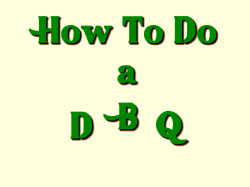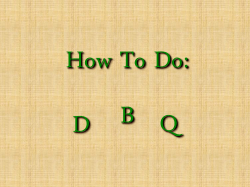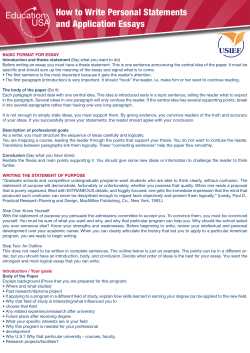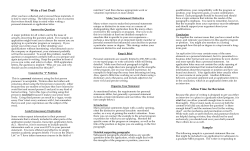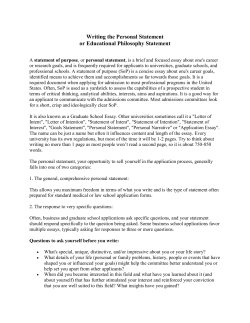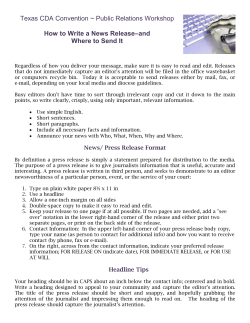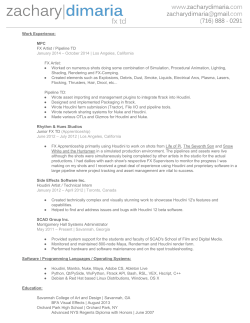
How to start your Expository Research Paper with an Introductory Paragraph:
Handout #_____ How to start your Expository Research Paper with an Introductory Paragraph: “Expository writing” is writing that explains or proves something. You’re trying to prove/explain how your chosen topic (person or corporation) has left a legacy. What is an introductory paragraph in expository writing? The introduction paragraph is the first paragraph of your essay. What does it do? It introduces the main idea of your essay. A good opening paragraph captures the interest of your reader and tells why your topic is important. The Introductory Paragraph starts with a Great first Sentence! First impressions are so important. It is true that the first impression—whether it’s a first meeting with a person or the first sentence of a paper—sets the stage for a lasting opinion. The introductory paragraph of any paper, long or short, should start with a sentence that piques the interest of your readers. Would you want your readers (including your teacher!) to read your paper’s unimpressive first sentence or first paragraph and assume the rest is just as unimpressive? Should your teacher “save a lot of time” by not reading the rest of it and just “give you” a C or D as a grade? OF COURSE NOT! So make sure your intro sentence is interesting! In a typical essay, the first sentence leads into two or three sentences that provide details about your subject or your process. All of the sentences build up to your thesis statement. The thesis statement is the main purpose/idea of the essay. The entirety of your paper hangs on that sentence. But its function is to be informative and direct. (This means that it’s not normally very “exciting”.) Your First Sentence To get your paper off to a great start, you should try to have a first sentence that engages your reader. Think of your first sentence as a hook that draws your reader in. It is your big chance to be so clever that your reader can’t stop. As you researched your topic, you probably discovered interesting anecdotes (stories), quotes or trivial facts. This is exactly the sort of thing you should use for an engaging introduction. Mrs. Tolin’s Student Research Packet. (This page was adopted & modified from http://www.apsu.edu) Handout #_____ Things NOT to do in an introductory paragraph: Apologize. Never suggest that you don't know what you're talking about or that you're not enough of an expert in this matter that your opinion would matter. Your reader will quickly turn to something else. Avoid phrases like the following: In my [humble] opinion . . . I'm not sure about this, but . . . Announce your intentions. Do not flatly announce what you are about to do in an essay. In this paper I will . . . The purpose of this essay is to . . . Get into the topic and let your reader perceive your purpose in the topic sentence of your beginning paragraph. Use a dictionary or encyclopedia definition. According to Merriam-Webster's Webster Dictionary, a widget is . . . Although definitions are extremely useful and it might serve your purpose to devise your own definition(s) later in the essay, you want to avoid using this clichéd beginning to an essay. Dilly-dally. Get to it. Move confidently into your essay. Many writers find it useful to write a warm-up paragraph (or two, even) to get them into the essay, to sharpen their own idea of what they’re up to, and then go back and delete the running start. If you need to do that, that’s fine… just make sure you delete all that unnecessary “warm up” wordiness later. While the opening paragraph should indeed be written in such a fashion that would encourage the reader to want to read the paper, the introductory paragraph is supposed to serve as an introduction—or an overview—of what the paper is about. What should I put in my intro paragraph? How do I write it? Begin with a “Hook” sentence to catch your readers’ attention. Since your paper is going to be discussing details of a person or corporation who has left a legacy, introduce any foundational or “background” information that is necessary for your reader to understand first before you get into the details. For example, you should provide a general explanation of “who” your person is. Perhaps you should mention that he/she is known as the “Founder of Rock ’n’ Roll” for example, so that your readers at least start with the foundational understanding that your topic is a musician. Or, perhaps you should start by defining what a “physicist” is or does, before stating that Albert Einstein (your topic) was a physicist. This paragraph is where you may want to discuss his/her date of birth or death, and other “bibliographic” information that is important for your readers to know about, but information that didn’t distinctly fit under any subtopic category such as Influences, Adversities or Accomplishments. Lastly, your introductory paragraph should contain a thesis sentence which will introduce your three subtopics (details) of your topic. The thesis is the core idea—focus--of the paper. It serves as the paper’s purpose, or the reason for writing about a given subject. Where does the thesis statement belong? Typically, the thesis statement should be placed at the end of the introductory paragraph so that it directly leads into the body paragraphs which will further explain each subtopic mentioned in the thesis. How long does my introduction paragraph have to be? A minimum of 5-7 sentences, with the last sentence being your (pre-approved) thesis statement. Mrs. Tolin’s Student Research Packet. (This page was adopted & modified from http://www.apsu.edu) Handout #_____ SAMPLE INTRODUCTORY PARAGRAPHS WITH THESIS Below are a few introductory paragraphs. The thesis statements are underlined to show you the beginning construction of a general essay. Topic: William Faulkner: The Dying Rose of Emily 1. In “A Rose for Emily”, William Faulkner’s use of imagery sets a tone for the general theme of the story, death. A rose to most is seen as an object of beauty, with such a sweet smell. In this story, we see Emily much like the rose, an object of beauty and desire that soon begins to wither and die. Faulkner, through great use of imagery, paints a vivid of a dying rose, Miss Emily. Topic: James Joyce: “Araby” 2. In James Joyce’s short story Araby he is successful in creating an intense narrative. He does this in such a way that he enables the reader to feel what is it actually like to live in Dublin at the turn of the century when the Catholic Church had an enormous amount of authority over Dubliner’s. The reader is able to feel the narrators exhausting struggle to escape this influence of the Catholic Church by replacing it with a materialistic driven love for a girl. Topic: Cloning 3. Imagine lying in a hospital bed about to die of heart failure, liver failure, or even kidney failure. Now imagine if the only way to live was to have an exact replica of your heart, liver or kidney. The only way that this could be possible was to have an exact clone made of your organ(s) through a scientific process called cloning. Now imagine that every piece of meat or animal that you eat was perfectly healthy for you. Once again the only way possible to do this would be to genetically clone an animal. Although many people may believe that cloning is omnipotent or unethical, one must realize the beneficial outcomes that cloning can bring forth to the human race. Topic: The Deviant Tone 4. Among the popular forms of alternative music is a lasting example of an embryonic culture known as rap. Rap music is very controversial. Some people think it is a fine piece of art while others think it is a horrid, non-talented, way of expressing feelings. Some of the lyrics that go along with this type of music are very explicit and have a large influence on our future teens and adults. While the lyrics are explicit, they can also be degrading, using both sexual and racist comments, to not only women but men as well. Also, rap music causes a lot of problems and disagreements between children and their parents due to their different styles. With today’s youth getting more involved with rap they become more influenced by what the songs are saying and they can sometimes affect them in a negative way or convince them to do things that would be considered wrong in today’s society. Mrs. Tolin’s Student Research Packet. (This page was adopted & modified from http://www.apsu.edu) Handout #_____ “HOOKS”/ ATTENTION-GETTING DEVICES for your Intro Paragraph The first several sentences of an introductory paragraph should consist of attention getting or interest sentences. Below are several examples of different techniques which may be used to lead the reader to the thesis statement, which is the final one or two sentences of the introductory paragraph. 1. NARRATION “Harry Houdini, the great escape artist, never ran out of ways to attract the interest of the general public. Even the events surrounding his death demonstrate his flair for the dramatic. According to an often quoted story, Houdini, just before he died, told his wife that he would communicate with her from "the other side." From his death to just before her death in 1943, when she gave up trying to reach him, this promise kept his widow from fading into obscurity. It was this ability to stimulate the interest of the public that also served him well in life, particularly during his performances. Houdini, a successful showman, knew how to captivate his spectators. He could excite them with the danger and suspense of his acts, amuse them with unexpected touches of humor, or stimulate their curiosity.” 2. FACTUAL DATA OR STATISTICS “Harry Houdini, the great escape artist was born in 1874. There has been some controversy over where he was born. Some biographers argue Budapest, Hungary; others, however, support his claim of having been born in Appleton, Wisconsin. This controversy notwithstanding, Houdini's real name was Erich Weiss, and at an early age Erich demonstrated an uncanny grasp of the art of trapeze flying. As he grew older, he became fascinated with magic and with the fantastic tricks of such performers as the French magician Robert-Houdini, from whose name he later derived Houdini. It was from such magicians that he also gained his showmanship. Houdini, a successful showman, knew how to captivate his spectators. He could excite them with the danger and suspense of his acts, amuse them with unexpected touches of humor, or stimulate their curiosity.” 3. QUOTATION “In his article on "conjuring" in the 1926 Encyclopedia Britannica, the great master of escape Harry Houdini asserted that he owed his success to his "great physical strength and the fact that he [was] slightly bowlegged." But when one reads about the remarkable career of this amazing performer, one finds the man's showmanship more impressive than his athletic attributes. Houdini, a successful showman, knew how to captivate his spectators. He could excite them with the danger and suspense of his acts, amuse them with unexpected humor, or stimulate their curiosity.” 4. STARTLING STATEMENT “It has been said that each of us, at one time or another, considers committing suicide. But the real tragedy is that each year more than half a million people not only contemplate suicide but actually succeed in taking their own lives. This high suicide rate is influenced by a number of factors. Among them are psychological states, sociological conditions, and ineffective means of prevention.” 5. GENERAL STATEMENTS “Mention life insurance to most people, and they confess that they are confused about the subject. Some even swear that their insurance agent had to get special training to deal with the difficult language of life insurance. People need not be confused, however, because there are actually only three basic types of life insurance-ordinary life, term life, and endowment life--and each has features designed to meet particular requirements. Fast-food restaurants are becoming more and more popular in the United States. The rapid pace of contemporary society and the need of those "on the go" for quick meals bring the American public through the doors of fast-food restaurants in ever-increasing numbers. No longer is the fast-food restaurant primarily a hangout for teenagers. On the contrary, during recent years people of all ages have come to rely on fast-food outlets as a means of satisfying their appetite for the all-American meal of hamburger, French fries, and soft drink. Playing host to such a mass of hungry drop-ins is bound to put a strain on those who work in a fast-food restaurant. Of the different types of customers who frequent fast-food restaurants, some are more welcome Mrs. Tolin’s Student Research Packet. (This page was adopted & modified from http://www.apsu.edu) Handout #_____ than others. In particular, three types of customers become very familiar to those who must serve them: the impatient ones, the picky ones, and--perhaps the salvation of the employees--the easy-to-please ones.” 6. COMBINATION “Born in 1874, the great escape artist, Harry Houdini lived in an age that, as a result of new advances in science, was Factual detail fascinated with the unusual and inexplicable. The Great Houdini took advantage of his audience's taste, performing Generalization seemingly impossible tasks and reaping their wonder and Generalization appreciation. If his audiences had only known the most of Generalization what they saw during a performance was easily accomplishable for a "slightly bowlegged" man of "great physical strength," Quotation they might not have been quite so impressed. Houdini, however, was a successful showman who knew how to captivate his spectators. He could excite them with the danger and suspense of his acts, amuse them with unexpected touches of humor, or stimulate their curiosity.” WHAT NOT TO SAY IN YOUR INTRODUCTION 1. Avoid telling the reader that you are beginning your essay: “In this essay, I will discuss . . .” “I will talk about . . .” “I am going to prove . . .” 2. Do not apologize in your paper: “Although I am not an expert . . .” “In my humble opinion . . .” 3. Do not refer to later parts of your essay: By the end of this essay one will agree . . . In the next paragraph people will see . . . 4. Do not use lame expressions. Since they have been so overused, they will lack interest. Using such expression shows that you have not taken time to use your own words to express your ideas. Some examples of corny expressions are: “busy as a bee” “you can't tell a book from its cover” “haste makes waste” 5. Do not make your introduction too long. This paragraph usually needs about half as many sentences as your body paragraphs. (The length of the introduction may vary in proportion to the length of the essay. A long 2,000 word research paper may require a longer introduction.) 6. Do not use second person “you” as if your reader were sitting next to you. ANOTHER Sample Introduction Paragraph [ATTENTION-GETTER] According to the Florida Museum of Natural History, there are about 50-75 shark attacks worldwide each year (“International Shark Attack File 2012”). Bethany Hamilton, now a twenty-three year old winning professional surfer, was one of these people who contributed to that statistic in 2003 when she survived a shark attack at the age of thirteen (Patterson 51). Bethany has lived in Hawaii and surfed almost her entire life, and she was training to become a professional surfer when she was attacked and lost her left arm (Viti 33). [BEGIN SETTING-UP THE THESIS] Although she faced many difficult challenges after the shark attack, she advises those who have dealt with hardship and states, “Stay on top game no matter what adversity comes your way. Be your beautiful, healthy, unique self and love beyond yourself!” (Viti 32). Despite the many challenges that she has had to face, Bethany has become a Mrs. Tolin’s Student Research Packet. (This page was adopted & modified from http://www.apsu.edu) well-known surfing figure and inspiration throughout the world, and she continues to surf today. [THESIS] Bethany Hamilton is a passionate surfer who was influenced by her family and her faith in God, struggled through many adversities caused by her shark attack, yet used her accomplishments to inspire faith and Handout #_____ Writing a Research Paper Structural Outline: INTRODUCTION: Your introduction should include your thesis statement, purpose of the paper, and necessary background information. BODY: I. All paragraphs should begin with a main idea sentence (Topic Sentence), and then include the following: A. Supporting/developing detail sentence i. subdetail sentence for explication/ development B. Supporting/developing detail sentence (if needed) C. Example to support detail sentence D. Explication of example—showing HOW it supports your idea. E. Continue with as many paragraphs as you need for all of your main ideas using EXAMPLES for support. CONCLUSION: Summary/Conclusion statement. Clear and appropriate concluding statement that states something about the thesis in light of the evidence used to support it. Mrs. Tolin’s Student Research Packet. (This page was adopted & modified from http://www.apsu.edu)
© Copyright 2025
